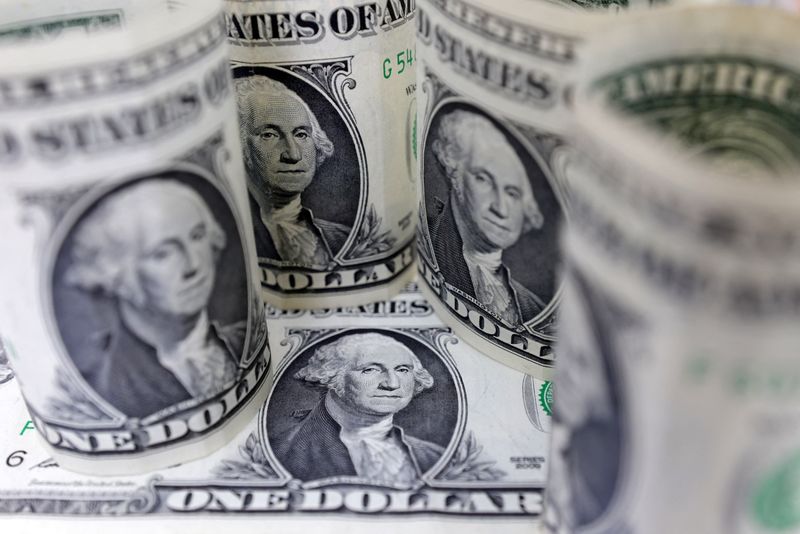

© Reuters. FILE PHOTO: U.S. Dollar banknotes are seen in this illustration taken July 17, 2022. REUTERS/Dado Ruvic/Illustration/File Photo
By Gertrude Chavez-Dreyfuss
NEW YORK (Reuters) -The U.S. dollar was little changed to modestly higher against a basket of currencies on Monday ahead of central bank policy decisions in Japan and the euro zone that may determine the currency’s direction this year.
Japan’s yen moved away from Friday’s 148.80 per U.S. dollar, its weakest in a month, and rose to as high as 147.61, as the BOJ started its two-day policy meeting. The dollar was last down 0.1% against the Japanese currency at 148.06 yen.
Wagers for an exit from negative rates at this meeting have been wound down following the New Year’s Day earthquake on Japan’s west coast, alongside dovish BOJ commentary.
“BOJ Governor (Kazuo) Ueda is likely to tilt against expectations for an April move out of negative-rates territory in the post-decision press conference, and the bank may lower its full-year inflation forecast, pulling the yen closer to the 150 threshold against the dollar,” said Karl Schamotta, chief market strategist at Corpay in Toronto.
The yen, which is sensitive to the difference in interest rates between the U.S and Japan, has been the worst hit against the dollar this year, tumbling about 5% in a swift reversal of December’s bounce to five-month peaks near 140.
“It’s incredibly unlikely they’ll (BOJ) actually touch their benchmark policy rate, but comments from currency officials are proving to once again have a bit of weight on the (dollar/yen) pair,” said Helen Given, FX trader, at Monex USA in Washington.
“We’ll have to see whether Ueda mentions FX pricing in his press conference following the decision. To put things into context though, this is a relatively small retracement to the losses JPY has taken so far this year.”
Traders said one factor also driving the yen moves was the expiry of a large amount of currency options this week and the hedging around those contracts.
LSEG data showed strike prices between 147.15 and 148.10 dollar-yen levels this week totalled around $2.6 billion.
The European Central Bank is also holding a policy meeting this week and is expected to leave rates unchanged at 4%, with ECB officials saying it is too early for rate cuts. With the ECB likely to remain data-dependent, investors will focus on the tone of the policy statement and President Christine Lagarde’s press conference.
The euro was last down 0.1% on the day at $1.0883. Speculators pared back net long positions on the euro to their lowest since early November, data from the Commodity Futures Trading Commission showed last Friday.
The was flat to slightly higher at 103.34. It has gained the most among developed market currencies in January, rising about 1.8% from the start of this year. Its rally, however, has been up and down as investors try to make up their minds about when the Federal Reserve will start cutting rates.
Data late last week showing U.S. economic activity remains resilient despite interest rates at their highest level in decades caused markets to scale back expectations of rate cuts beginning as soon as March.
The U.S. rate futures market on Monday priced in a roughly 40% chance of a rate cut at the March meeting, down from as much 80% 1-1/2 weeks ago, according to LSEG’s rate probability app. For 2024, futures traders are betting on five rate cuts of 25 bps each, compared with expectations of six two weeks ago.
In cryptocurrencies, bitcoin fell below $40,000 for the first time since early December, as investors continued to book profits following the U.S. approval of spot bitcoin exchange-traded funds a few weeks ago.
The world’s largest cryptocurrency in terms of market capitalization dropped to $39,335.37, the lowest level since December 4. was last down 3.5% at $40,284. So far this year, bitcoin has fallen 5.3%.


